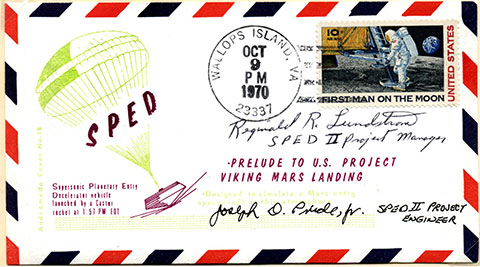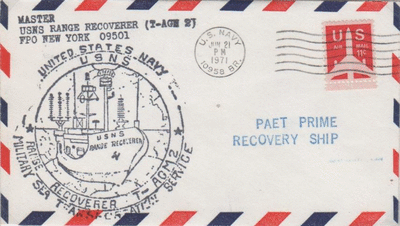Space Cover 361: SERT and PAET Launch and RecoveryThe Supersonic Planetary Entry Decelerator (SPED) was a new type of parachute with a strip of cloth just below the main parachute and forming a full circle beneath it as shown on the cachet of the above cover. It was called a "disk-gap-band parachute (DGB) designed to assist in landing scientific instrument on Mars. SPED was an experiment that obtained the deployment characteristics of this parachute in the wake of a blunt body at Mach 2.6, and a dynamic pressure of 19.7 pounds per square foot. The 3,058 pound SPED payload was launched by a single stage Castor rocket with two smaller Recruit rockets attached for additional thrust.
A 40-foot-diameter disk-gap-band parachute was flight tested as part of this program. The test parachute was deployed from an instrumented payload by means of a deployment mortar when the payload was at an altitude of 158,500 feet (48.2 kilometers), a Mach number of 2.72, and a free-stream dynamic pressure of 9.7 pounds per foot. The DGB opened behind the aeroshell. The on-board cameras an equipment along with the aeroshell were recovered about 70 miles from Wallops Island.
This was determined to be the most practical and cost effective way to qualify the Mars Supersonic Landing parachute for the Viking program. This same general approach has been used by all heritage Mars surface landers flown since Viking including: Mars Pathfinder (MPF), Mars Polar Lander (MPL), the Mars Exploration Rovers (MER), Beagle 2, and Mars Scout Phoenix (MSP). The parachutes for all of the NASA post-Viking missions to Mars were developed and fabricated by Pioneer Aerospace Corporation using similar materials and construction techniques.
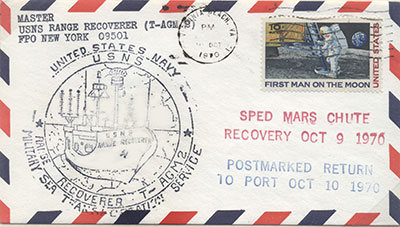
The USNS Range Recoverer was a missile range instrumentation ship that tracked this parachute test and is not a commonly seen cover.
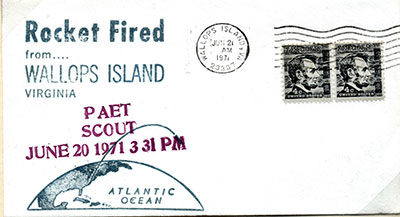
The Planetary Atmospheric Entry Test (PAET) was launched on June 20, 1971 from Wallops Island, VA.The measurements, carried out during the descent of the probe from an altitude of 42 miles into the sea, were a success.
The concept, from the Ames Research Laboratory, was demonstrated by PAET in Earth's atmosphere and later used to investigate the atmospheric structures of Mars, Venus and Jupiter. PAET was in fact, the world's first re-entry atmospheric reconstruction experiment.
By 1970, NASA had established a planetary exploration program for future missions to Mars, Venus, Saturn and Jupiter. One of the primary objectives of these interplanetary missions was to gain a better understanding of atmospheric properties on other planets, but the methods and instrumentation necessary to achieve this end had to first be tested.
The PAET project was the first time that this type of probe technology was tested. The aim of the PAET project was to expand on the understanding of atmospheric structure by taking measurements of atmospheric effects on spacecraft specifically during planetary entry. Included in the instrument package were accelerometers, radiometers, pressure sensors and temperature sensors, all of which were collectively employed to determine pressure, temperature, stagnation pressure, density changes with different altitudes, mean molecular weight in the atmosphere and water vapor. A mass spectrometer was employed for the purpose of effectively determining gas species.
Most instruments, as well as the body of the PAET spacecraft were designed, fabricated and tested at Ames. The craft consisted of the entry vehicle and the entry vehicle separation system for a combined weight of 296 pounds. The entry vehicle consisted of a blunt shaped fore-body and a honeycomb shaped after-body. It was 36 inches in diameter and 25.2 inches long. Before launch the aerodynamic shape of the spacecraft was studied with tests in the NASA Ames Hypervelocity Free Flight Tunnel.
The craft's flight from liftoff to splashdown totaled just over 13 minutes with a peak altitude of 250 miles and entry trajectory commencing at nearly 150 miles. Data was collected primarily at the MSFN in Bermuda near impact, but the MSFN Tracking Ship USNS Vanguard and three telemetry ships, including the USNS Range Recoverer were also employed to provide stored telemetry data gathered during radio signal blackout. Participants and analysts involved with PAET determined that the instruments and techniques being tested were largely successful.
Measurements taken of atmospheric structure, temperature profile and mole fractions of major gases were all deemed accurate and satisfactory. The one conspicuous problem was an apparent blocking of the hole at the nose of the craft through which the mass spectrometer was to take gas samples. It was concluded that the PAET succeeded in supporting forthcoming missions to Mars, Venus, Jupiter and Saturn with the respective Viking, Pioneer Venus, Galileo and the Cassini Huygens projects.
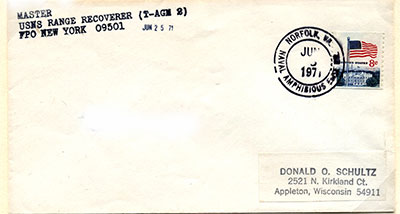
The USNS Range Recoverer was built as a a Coast Guard-manned Army vessel commissioned at New York on 25 November 1944. On 27 November 1960 she was reclassified USNS and designated T-AGM-2. She was equipped with telemetry, data processing and radio instruments as well as recovery facilities to retrieve nose cones.
Manned by a Civil Service crew of the Military Sea Transportation Service, Range Recoverer served to support the NASA facility at Wallops Island, Virginia. NASA technical party operators used on board equipment, including helix antennas, data recording systems and a communications suite with direction finders to locate and recover payloads.
Again, this is a not-too-often seen cover for this event.











